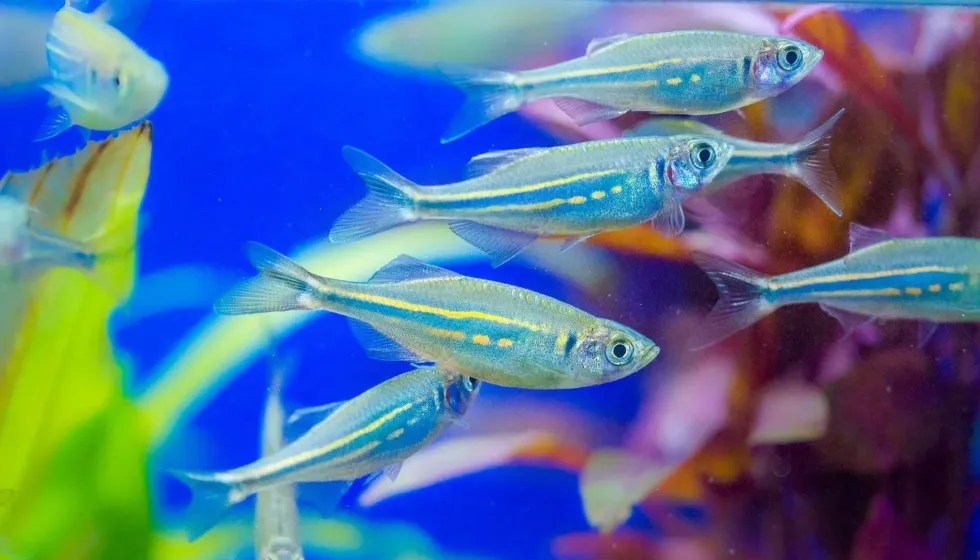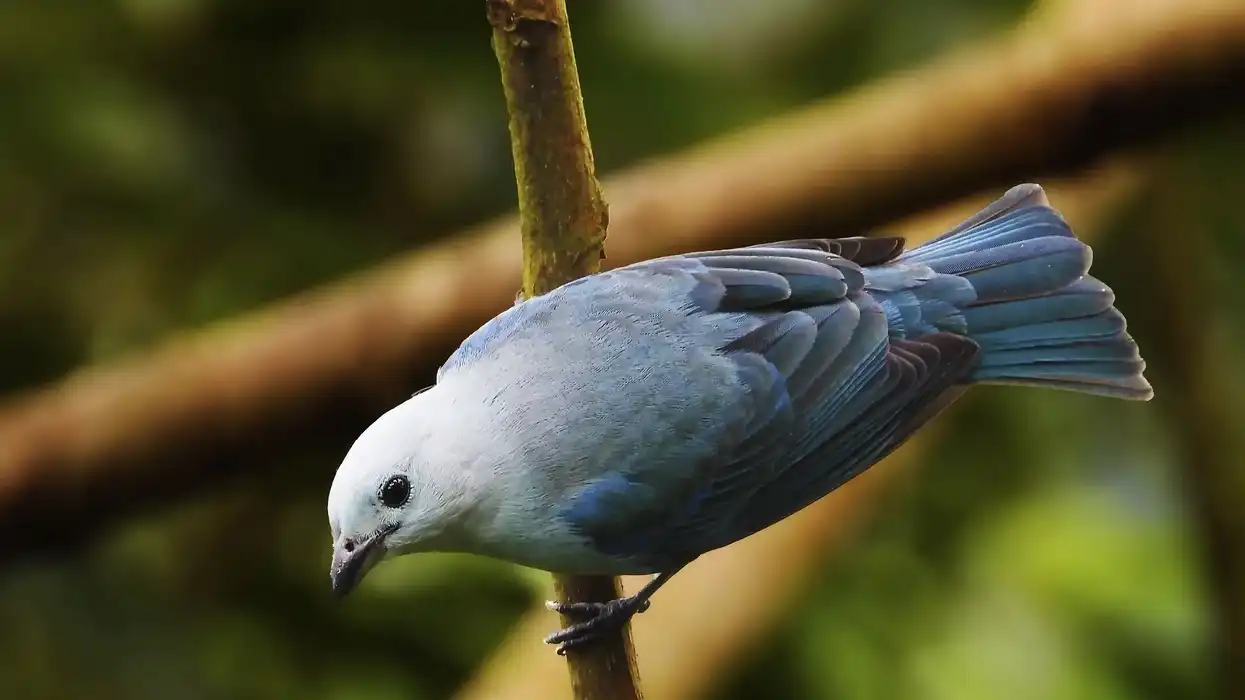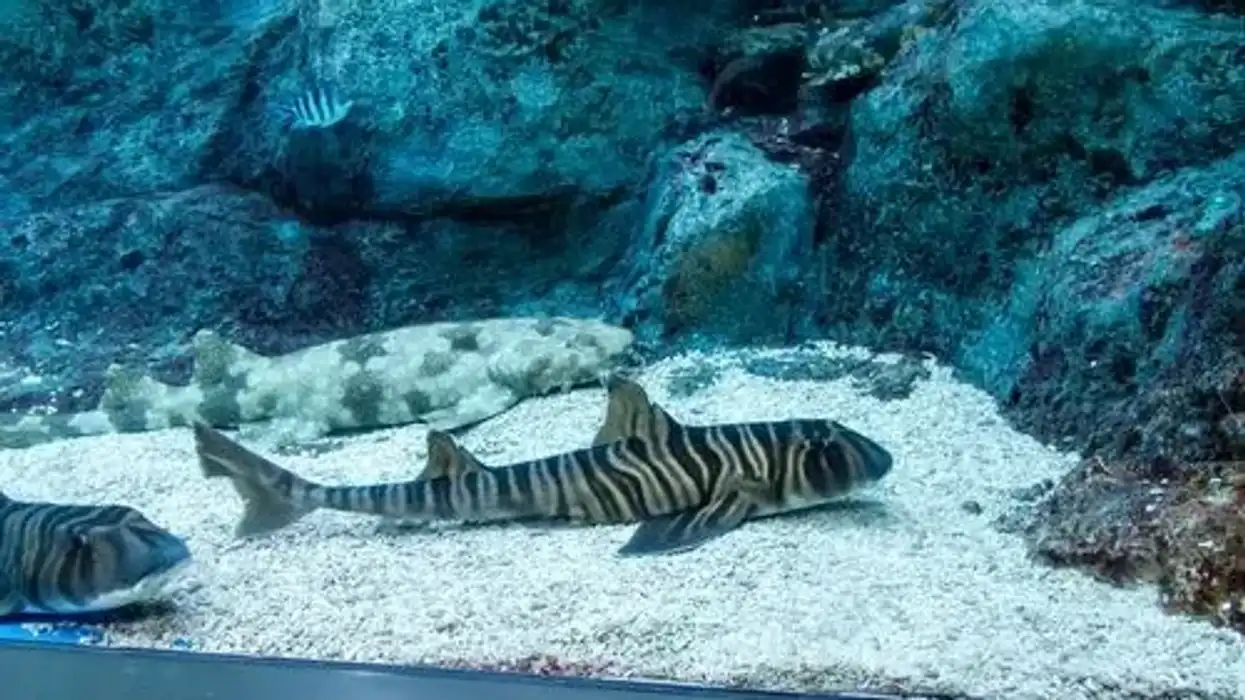The blue danio (Danio kerri) is a vibrant, colorful, hardy, active, and peaceful tropical fish species widely popular as an aquarium pet. Also known as Kerr's blue danio, royal blue danio, or turquoise danio, the fish species is native to the Malay Peninsula and belongs to the family Cyprinidae, which also includes the true minnows, carps, barbs, and barbels.
The genus Danio comprises small freshwater fish native to South and Southeast Asia. Characterized by striking colors and unique patterns of spots, stripes, and vertical bars, the members of the genus Danio are commonly kept as aquarium fish.
Currently, the genus has 27 recognized species, and one of them is Danio kerri or the blue danio fish. Some other well-known danios include the zebra danio or zebrafish (Danio rerio), pearl danio (Danio albolineatus), rose danio (Danio roseus), and the glowlight danio (Danio choprae).
As evident from the name, the blue danios are blue in color, with several gold/pinkish lines running from the tail to the gills. It is a peaceful schooling fish species that makes an aesthetic addition to community aquariums.
In their wild habitat, the blue danios reside in clear streams and surrounding pools. The blue danio fish typically live in open water habitats, which may include aquatic plants. Most danio species feed on crustaceans, worms, and small aquatic insects.
Read on to know more such interesting facts about the blue danios! If you like what you read, do check out similarly fun and interesting facts about the rose danio and harlequin bass.
Blue Danio Interesting Facts
What type of animal is a blue danio?
The blue danio (Danio kerri) is a freshwater fish species of the family Cyprinidae. It is a peaceful, hardy, and active tropical species popular as an aquarium fish. Other names for the fish are turquoise danio and Kerr's blue danio.
What class of animal does a blue danio belong to?
The blue danio (Danio kerri) belongs to the class of ray-finned fishes.
How many blue danios are there in the world?
The global population size of the blue danio fish is not available. Since the species is widespread as an aquarium fish, it can be considered that its numbers are in abundance.
Where does a blue danio live?
The blue danio fish (Danio kerri) is native to the Malay Peninsula in Asia. Since the blue danio fish is popular in the aquarium trade, it is widespread in aquariums and tanks around the world.
It thrives well in aquariums with a good amount of plants and decor such as driftwood and rockwork. Even though the blue danio is a tropical species, its hardy nature makes it accepting of colder waters as well. The vibrant colors of the fish are most remarkable against a dark substrate.
What is a blue danio's habitat?
In its natural habitat, the fish lives in clear streams and surrounding pools. The wild habitat of the blue danio fish typically has a lot of open water along with an abundance of aquatic plants. The species may also be found in places with dense vegetation.
The blue danio fish is popular in the aquarium trade, and keeping it in an aquarium/tank requires very little effort by the owner. Since it is an active schooling fish with peaceful behavior, they are best kept in groups.
The blue danio fish prefers an aquarium/tank decorated with lots of plants with enough space for shoaling. Being a tropical fish, the blue danio thrives best at a water temperature range of 73-77 ℉ (22.77-25 ℃).
Further, the pH of the aquarium/tank water should be in the range of 6.5-7.0, with the water hardness in the range 5-12 dH.
The species is benthopelagic, meaning it can feed at the water surface as well as at the bottom. In addition, the fish prefers clean and well-oxygenated water.
Higher levels of oxygen can be achieved in the aquariums by using an air pump, especially if you have more fish and fewer plants in the aquarium/tank. Having a densely planted area along the back and sides of the aquarium/tank is always a good idea if you decide to keep this species of fish.
Who do blue danios live with?
The blue danio is a schooling fish and lives in groups in its natural environment. The blue danio fish has a peaceful behavior and gets along well with any smaller and peaceful fish species unless the latter is spooked out by the danio's active nature.
The fish is also compatible with smaller and peaceful invertebrates, provided they are not too small for the blue danio to feed on. For instance, the blue danio is a predator to dwarf shrimp fry.
How long does a blue danio live?
The blue danio fish has a lifespan of around two to four years.
How do they reproduce?
In the wild, the blue danio fish can be found spawning on coarse gravel beds. Members of the species are egg-scatterers.
Spawning usually begins very early in the day, and the eggs take about 36 hours to hatch. The blue danio fish also spawn in community aquariums.
It is pretty easy to breed the fish in an aquarium, but the chances of survival of the fry (young fish) are very low. Moreover, the danio fish male and female parents show no kind of parental care and instead eat their own eggs and fry!
Blue danios are best bred in an aquarium that receives ample morning sunlight. The aquarium should house some fine-leafed plants and a bottom covered with layers of marbles or mesh to allow the eggs to fall through and protect them from being eaten up by adult males and females.
Lowering the water temperature of the aquarium also helps to trigger the spawning process. Before the fish are bred, they must be fed a varied diet in order to get the maximum amount of fry.
For this, it is best to separate the males and females for a few weeks while they are being fed the variety diet before breeding.
The fry is capable of free-swimming about seven days after they hatch. They are initially fed very small food and can later be given brine shrimp and crushed, flake, or frozen food as they grow.
What is their conservation status?
As per the International Union for Conservation of Nature (IUCN) Red List, the blue danio (Danio kerri) is a species of Least Concern.
Blue Danio Fun Facts
What do blue danios look like?
The blue danio is blue in color with powdery blue flanks. One or more pinkish-gold stripes run from its tail to almost halfway up the body.
The stripes may or may not be broken. Differentiating between a male and female blue danio can be done in the same way as that for the zebra danio or zebrafish (Danio rerio). Whiles the females are larger and fatter, their male counterparts are comparatively smaller and more slender.
How cute are they?
The small size of the danio fish imparts a certain degree of cuteness. The blue and gold colors of its body make it look absolutely spectacular, especially when contrasted against a dark aquarium substrate.
How do they communicate?
Overall, the blue danio is a peaceful fish that interacts well with other smaller species. However, no specific information is available regarding how it communicates.
How big is a blue danio?
The blue danio can grow to a length of about 2 in (5 cm). It is the same size as the zebra danio and about an 1 in (2.54 cm) longer than the white cloud mountain minnow.
How fast can a blue danio swim?
An estimate of the blue danio's swimming speed is not available. It is known that the species is active and fast-moving.
How much does a blue danio weigh?
The weight range of the blue danio is not available. The fish would roughly be the same build as a minnow.
What are the male and female names of the species?
Male and female danios do not have distinct names.
What would you call a baby blue danio?
Like all other fish, a baby danio would be called fry and, later, a fingerling when it has developed scales and fins.
What do they eat?
The blue danio is a micro predator by nature and consumes a carnivorous diet. It mostly preys on tiny aquatic invertebrates such as insects, worms, and crustaceans.
When kept in an aquarium, the blue danios are not very fussy or choosy about their diet. It is quite easy to feed and will eat almost any dry food.
The fish can be kept and bred in an aquarium with a diet of high-quality flake food. However, it is essential to provide a varied diet to the danio and supplement its flake food base with frozen or live meaty food. Mosquito larvae in the live or frozen form also work well.
Are they dangerous?
Blue danios are completely harmless.
Would they make a good pet?
The blue danio is a friendly and peaceful creature and makes an excellent pet.
Did you know...
The longfin blue danio is a color variation of the zebra danio.
The specific epithet of the blue danio (Danio kerri) honors Arthur Francis George Kerr, who collected the first specimen in 1929.
How many danios should be kept together?
When kept in an aquarium/tank, the blue danio should never be kept in groups of less than six to eight individuals. In fact, the larger the school, the better.
Danios and other fish
The danios are friendly and compatible with several other species such as small barbs, swordtails, mollies, platys, tetras, kuhli loach, cory catfish, guppies, harlequin rasbora, honey gourami, ghost shrimp, and other danios.
Here at Kidadl, we have carefully created lots of interesting family-friendly animal facts for everyone to discover! Learn more about some other fishes from our longhorn fish facts and milkfish facts pages.
You can even occupy yourself at home by coloring in one of our free printable blue danio fish coloring pages.
Second image by Lerdsuwa.









